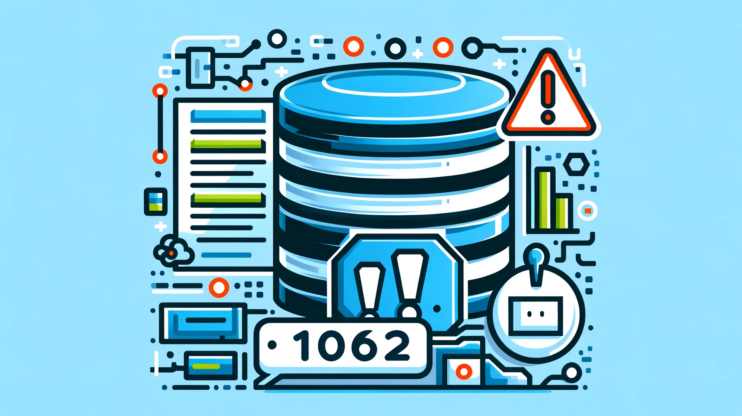If you’ve bumped into the MySQL error code 1130 (HY000), reading “Host ‘host_name’ is not allowed to connect to this MySQL server,” you’re not alone. This hiccup is pretty common among IT professionals and website developers who rely on MySQL, a leading open-source relational database management system.
When setting up a MySQL server, it’s crucial to configure which computers or networks have the green light to connect. This setup is key to getting your database server up and running smoothly.
Why it’s a big deal to fix MySQL error 1130 (HY000)
Encountering MySQL error 1130 (HY000) means there’s a snag in the communication line between your computer and the MySQL server. This glitch can lock you out from accessing vital data stored in databases on the server.

Considering how crucial data storage and management are in the digital realm, this issue could spell trouble, leading to potential revenue loss or setbacks in application development. Hence, jumping on a fix for ERROR 1130 (HY000) is critical.
Peeling back the layers of MySQL error 1130 (HY000)
ERROR 1130 (HY000) pops up when there’s a no-go for host connections to the MySQL server. This issue can surface when trying to link up from one machine to another or between virtual environments.
The reasons behind this error vary, including incorrect login credentials or IP address blocks due to firewall settings or MySQL’s user table restrictions.
How to fix error 1130 (HY000) in MySQL
To investigate MySQL error 1130, start with firewall checks, ensure login credentials are correct, and confirm that client and server setups are compatible.
Let’s dive into the details of how to smooth out these bumps.
Check MySQL user privileges
The roadblock you’re facing with MySQL error 1130 might stem from a lack of privileges.
Picture this: you’re trying to enter a members-only club, but your name’s not on the list. Similarly, MySQL needs to know your user has the right permissions to waltz through its doors.
Checking privileges: Log in as the root user in MySQL and enter:
SHOW GRANTS FOR 'user'@'localhost';
Replace ‘user’ with your username. This command is your guest list check. If it returns limited or no privileges, you’ve found your culprit.
Granting permissions: If your user is indeed missing from the guest list, it’s time to VIP them with:
GRANT ALL PRIVILEGES ON *.* TO 'user'@'localhost'; FLUSH PRIVILEGES;
This command is like giving an all-access pass to your user. Remember to swap ‘user’ with the actual username.
Check firewall settings
Sometimes, the issue isn’t with MySQL itself but with a digital bouncer of sorts – your firewall. It might be inadvertently blocking the handshake between your server and MySQL.
Windows users:
Head over to Control Panel > Windows Firewall > Advanced Settings > Inbound Rules. Here, you’re checking if the firewall is to blame for stopping MySQL traffic.
Linux users:
Dive into your terminal and employ iptables commands or UFW to inspect firewall settings. You’re looking for any rules that might be giving MySQL the cold shoulder.
If you find that the firewall is indeed blocking MySQL, you’ll need to open the port MySQL is listening on (usually 3306) and adjust the settings to welcome MySQL traffic with open arms.
Check MySQL configuration file
The MySQL configuration file, or my.cnf, is essentially the rulebook that tells MySQL how to behave. Think of it as the settings for your favorite video game; if something’s off, the game won’t play right.
Editing the configuration:
Use sudo nano /etc/my.cnf to open the file. Here, you’re looking for the bind-address line. Changing its value to "0.0.0.0" is like saying, “Everyone’s welcome!” Alternatively, setting it to your local IP address restricts access to local connections only.
Adjusting the port:
If MySQL is throwing a party on a different port, find the port line and change its value accordingly.
Restarting MySQL service
After tweaking your settings, you’ll need to let MySQL know it’s time to apply them. This is akin to restarting your computer after installing new software.
Windows:
Navigate to Control Panel > Administrative Tools > Services, find MySQL and hit restart.
Linux:
Use sudo systemctl stop mysql.service followed by sudo systemctl start mysql.service to give MySQL to ensure the server picks up on your changes.
Preventing MySQL error 1130 in the future
Prevention is like keeping your digital health in check. Here are a couple of tips to keep MySQL error 1130 and other issues at bay:
- Good Security Practices: Limit access to your MySQL server to those who truly need it. Use strong passwords and avoid the root account for everyday tasks. This is digital hygiene 101.
- Regular Updates: Stay on top of updates and patches from MySQL. These updates are like vaccinations for your server, keeping it healthy and robust against vulnerabilities.
Following these steps not only addresses ERROR 1130 (HY000) but also fortifies your server against similar issues in the future. With a bit of patience and some command line magic, you’ll have MySQL running smoothly again.
Wrapping it up
Navigating through MySQL error 1130 can initially seem daunting, but with the right approach, it’s manageable.
From understanding the error to applying specific fixes and maintaining a secure, updated MySQL setup, you’re equipping yourself to handle this common yet fixable issue efficiently. Remember, in the tech world, being proactive about security and updates is always better than reactive troubleshooting.














